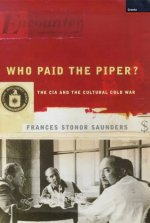
Who paid the Piper?
Frances Stonor Saunders
509 pages, including index and notes
published in 1999
Documents referring to this site within the last 24 hours (minimum 2 references):
List referrers to your own site with a single Javascript command (free!): click here.
With the recent revelations about how the Pentagon paid journalists to plant propaganda, the story in Who Paid the Piper? has become relevant again, as it is an examination in how the CIA fought a cultural Cold War from the late forties until at least the early seventies. Over three decades the CIA, via various front organisations poured millions into cultural events and institutions to promote America, its culture and its politics. In doing it created a class of artists, intellectuals and cultural commentators as much a creation of the state as their counterparts in the USSR were and warped the natural development of the arts in both America and Europe.
In the late 1940ties the US was losing the propaganda war in Europe. The continent was still not recovered from the ravages of World War II, millions were still unemployed and only communism seemed to hold an answer. In both France anfd Italy there were strong communist parties whom by the next elections might come into power and the USSR still enjoyed a massive prestige thanks to its part in the defeat of fascism. It was not just the workers who wanted communism, in intellectual circles as well communism was de rigeur.
To combat this, a credible anti-communist leftwing alternative needed to be created, seemingly independent from Washington but operating on behalf of American values, promoting the cause of America and controlled by CIA money. Over time, thanks to this CIA money, a complex network of non-profit cultural groups, political and cultural magazines, art congresses, exhibitions and orchestra tours was brought to life. The way Saunders tells it, this at first was not so much a considered strategy, but a response by midlevel CIA operatives to local circumstances. It was only after the first initial successes that more permanent structures were set up.
The spider in the CIA's web was the Congress for Cultural Freedom, through which anticommunist political magazines all over the world were founded and which also organised congresses and such. This was the first, most blatant part of the CIA's efforts. The second part was more subtle, but also more straightforward, the sponsoring of suitable examples of American arts as cultural embassadors. This included art exhibits, classical music orchestra tours as well as tours of Black artists in Europe, ballet and theatre troupes, etc.
What was intended to be achieved by this second approach was not just the promotion of the US as a cultural haven --though this was important in an Europe that saw the US still as semi-barbaric-- but also to promote art as non-political, to remove the space for political statements from art and counter the appeal of communism that way.
Somewhat ironically, the rightwing communist witch hunt of the fifties actually endangered this grand scheme, as the 'wingers did not object to communism, but to any hint of leftwing politics in official US projects, as well as any sort of "indecent art". The CIA at this point was still dominated by the old East Coast financial and cultural liberal elite, often also the people in charge of the big art funding foundations, like the Ford and Rockefeller foundation, while many of the people directly involved with the Congress for Cultural Freedom and such were embittered ex-communists themselves... Yet another example of how easily socalled liberals and "decent leftists" can let themselve been used as propagandists for imperialism. The arguments and justifications of people like Sidney Hook for their work read uncannily like what people like Christopher Hitchens or Norman Geras are saying now.
Most of Who Paid the Piper? is just an overview of the various activities the CIA and its front groups undertook in their campaign against communist art, as well as the history of how this campaign came into being, grew and was finally uncovered. Though Saunders is disapproving of these activities, little is done to put them in a wider context of Cold War politics and American imperialism. Instead, these activities are portrayed as just another part of US-USSR rivalries, when in fact they were as much aimed at independent socialist thought as at the USSR supported communist parties. Nevertheless this is still an important book, as it shows how far the US is willing to go in not just influencing but manipulating public opinion.
